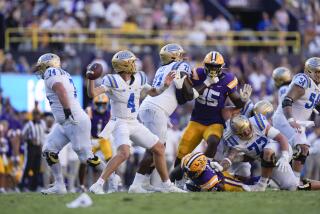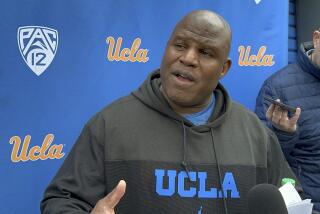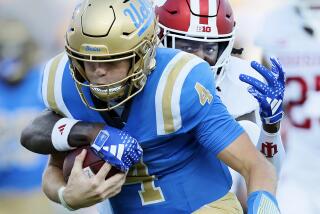Bruins focus on their run game in preparation for Hawaii

About two hours before the pandemonium at the Rose Bowl, there was mock applause.
UCLA tailback Bolu Olorunfunmi took a handoff late in the second quarter Sunday, stutter-stepped outside the left tackle and plowed ahead for a seven-yard gain on second and six. It was the Bruins’ first first down since their opening drive of the game. The scoreboard read Texas A&M 31, UCLA 3.
Fans who hadn’t had much to cheer finally did, though it sounded less than wholehearted.
The Bruins’ struggles that required the greatest comeback in school history were largely rooted in the running game — their inability to generate one or to stop Texas A&M’s tailbacks from leaving cleat marks on what looked like every inch of the field.
UCLA coach Jim Mora referenced those issues early and emphatically during his postgame remarks, citing the need to improve before the Bruins (1-0) face Hawaii (2-0) on Saturday at the Rose Bowl.
“We’re not going to let the euphoria of this big win overshadow all of the things that we need to fix,” Mora said after his team’s 45-44 victory over Texas A&M. “We have to be able to run the ball better than we did. I thought we’d be able to run it better; we didn’t run it well enough. We have to be able to stop the run. I thought we would be able to stop the run better.”
UCLA will encounter a similar style of offense run by the Rainbow Warriors, who have averaged 478 yards and 39.5 points per game while operating out of a spread attack. Tailback Diocemy Saint Juste rushed for 202 yards last week against Western Carolina, becoming the first running back in school history to top 200 yards twice in his career.
What type of defensive formation Saint Juste will face is in question. The Bruins abandoned their base 4-3 defense during the first half against Texas A&M, using an extra defensive back in an effort to counter an offense that featured three and four receivers.
It didn’t work. The Aggies rushed for 286 yards before halftime, including two lengthy runs that were especially deflating for the Bruins. After a UCLA punt had pinned Texas A&M at its one-yard line early in the second quarter, Trayveon Williams ripped off a 72-yard run that would have gone for a touchdown save for a flying tackle by Bruins cornerback Nate Meadors. The Aggies eventually reached the end zone anyway on Keith Ford’s two-yard run.
Texas A&M also had an immediate answer for UCLA’s first touchdown of the game, late in the second quarter. On the next play from scrimmage, Williams sliced through the Bruins defense for a 61-yard touchdown run.
“It’s the big plays that just demoralize you,” UCLA defensive coordinator Tom Bradley said after the game. “We fought back from that.”
The Bruins did so by switching to a base defense they had not practiced in two weeks. That meant inserting Lokeni Toailoa as a third linebacker in place of an extra defensive back, a halftime adjustment that helped to plug the running gaps that had been enormous in the first half. Texas A&M managed only 96 yards rushing in the second half, including 38 in the fourth quarter when it failed to put the game away.
Just because the desperation ploy worked doesn’t mean Bradley wants to go back to it because it leaves the Bruins in what’s known as “zero coverage” — without a safety manning the middle of the field.
“I don’t need the antacid. I’d rather not do that,” Bradley said. “That’s not exactly a sound way to win a football game.”
The Bruins also are searching for answers in their running game. Soso Jamabo replaced the largely ineffective Olorunfunmi as the primary tailback late in the second quarter and had some success, rushing for 46 yards in seven carries with a touchdown. Jamabo also helped his team convert a game-saving fourth down when he caught a swing pass and reached the first-down marker with less than a minute left.
Olorunfunmi finished with 31 yards in 10 carries and had a first-quarter fumble. Collectively, the Bruins generated only 63 yards rushing and 2.5 yards per carry — numbers even worse than last season when they finished No. 127 among 128 major college teams in rushing yardage per game.
UCLA center Scott Quessenberry attributed part of the inert ground game to “one-man breakdowns” and said it also was difficult to produce running yardage in comeback mode.
“Obviously in the run game, it’s kind of tough when you go down in the big hole early to get any sort of rhythm going,” Quessenberry said. “So it was pass, pass, pass toward the end of the game, and it worked out for us.”
The Bruins acknowledged that relying on a crazy comeback fashioned by quarterback Josh Rosen, who passed for 292 yards and four touchdowns in the fourth quarter, probably wasn’t a formula for long-term success. Running the ball and stopping opponents from doing so would be necessary to challenge for the Pac-12 Conference South Division title.
“We’re going to have to fix it; we don’t have much choice,” Bradley said. “We cannot win games like that.”
Follow Ben Bolch on Twitter @latbbolch
More to Read
Go beyond the scoreboard
Get the latest on L.A.'s teams in the daily Sports Report newsletter.
You may occasionally receive promotional content from the Los Angeles Times.







